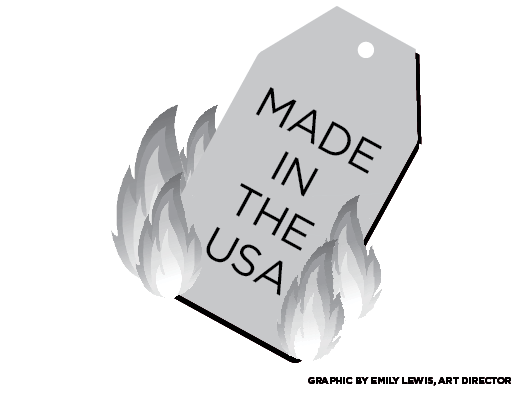
A year’s beginning is generally recognized to be a period of positive rebirth, but, for American Apparel, 2017 could not be bleaker. The Los Angeles-based clothing company has lost the financial war it has been waging for the last eight years, and the brand was officially sold to Canada’s Gildan Activewear last week.
Such an acquisition is not necessarily shocking, but there was a point when American Apparel, founded in 1989 by Canadian artist Dov Charney, was delightfully raking in the dough. This monetary success is what propelled the company to expand its presence beyond the low-key warehouses of wholesale and into the battleground of retail in the early 2000s. And in just three years, the brand’s iconic Helvetica-indebted marquee could be found illuminating the streets and malls of nearly a dozen countries. Still, the glory days were not glorious enough to keep American Apparel afloat past 2009 – the last year the company made a profit. Two filings for chapter 11 bankruptcy ultimately followed, and for the brand’s supporters, it was clear that the end was imminent.
Nonetheless, it is peculiar to witness the demise of a clothing company that has sprouted to be such a defining facet of millennial culture. American Apparel’s brand pervasiveness is so astounding that every young person exposed to trending fashion has, perhaps unconsciously, cultivated an opinion on the alliterative moniker, be it positive or panning. Even those who hate the company will admit to not necessarily disliking American Apparel products – simple, well-constructed wardrobe basics – but rather the subjective unaffordability of 20-dollar t-shirts, or the hip, arguably cavalier types that peruse the store’s racks. Only heightening the appeal of the brand are these ‘dislikeable’ characteristics, and for 20 and 30-somethings, American Apparel mirrors the former exclusivity of Jordache or Guess – premium brands that today’s middle-aged folks lusted after in their college days. Indeed, the designs offered in fast fashion retailers like H&M or Asos is evidence of how desired the American Apparel image remains, even through the company’s failure.
However, of greater importance than brand aesthetics and exclusivity was American Apparel’s ethical conscious that was maintained until its denouement. As a vertically integrated company, Charney’s anti-outsourcing brainchild relied on itself to not only manufacture its product, but design, distribute, market and sell it, too. This production system was based out of a seven-story, 800,000 square-foot factory in downtown Los Angeles, where garment laborers’ averaged a wage of 12 dollars an hour, plus benefits such as health care and paid time off.
In a perfect world, American Apparel’s practices would not be unique – they would be a standard. Yet, as the Department of Commerce’s Office of Textiles and Apparel continue to report that tens of billions of imports continue to dominate the U.S. apparel market, people are reminded of why, exactly, outsourcing and overseas manufacturing’s popularity dwarfs the chances of shoppers seeing “Made in the USA” tags on their favorite, low-cost products – fewer expenses.
Many people would rather not question why a US-made Patagonia down sweater jacket is $175, while an imported look-a-like can be found at H&M for less than a fourth of the price. They choose to not acknowledge how these apparel companies ruthlessly search across the world for foreign workers to exploit. A cheap coat from the mall has more value than the plight of the sweatshop laborer who was paid a 12-cent hourly wage to make it. From its conception nearly 30 years ago, the American Apparel brand stood for nothing short of its most promise — to make good products in an ethical way. And although the company loudly voiced its unique values whenever it could – storefronts of its retail stores boasted of bold “Made in the USA, sweatshop free” signs – too many consumers ignored those values.
In 2017, the fashion industry’s reprehensible immorality is no longer a secret. Aside from human suffering the industry is environmentally unsustainable. The fast fashion industry – referring to the business of offering cheap clothing that mimics high-end fashion trends – threatens the environment, and this relatively new method of production has allowed for the entire fashion industry to become the second largest polluter in the world, behind the oil industry. A variety factors are to blame, such as irresponsible uses of chemicals, water and the reckless disposal of garments. Half a trillion gallons of fresh water are used to dye textiles every year, but the dye wastewater, rife with chemicals, spreads throughout the oceans globally. This negative environmental impact is hardly worth an 8-dollar turtleneck from Forever 21 destined for the trash by the end of winter. Americans throw away 85 percent of their clothing, accounting for 9 percent of unrecycled waste.
One effective method of fighting against the fashion industry’s unsustainable practices is a no-brainer – people must invest in better-quality clothing. Uncoincidentally, luxury brands – those that manufacture their products with dignity, and sell them at a premium, of course – rarely come under fire for ethics issues in comparison to fast fashion companies. And as more socially responsible companies are cropping up and making money in the online retail sphere, it is becoming easier to give up wasteful fashion habits. Everlane, one of the most successful online-only, sustainable fashion retailers, preaches “modern basics, radical transparency,” with a focus on wardrobe necessities. The company, started in 2011, and today, is doing so well that Business Insider reports the San Francisco startup is giving shoppers the opportunity to choose how much they pay for the luxe garments.
In fact, it is the success of new, conscious companies like Everlane that reasonably justify the belief that American Apparel was simply ahead of its time and caught in a period of vast insecurity. Unlike the downfall of other specialty retailers, such as the dying Aeropostale or Abercrombie & Fitch, there was nothing unpopular or unstylish about the image or lifestyle that American Apparel symbolized. Regardless of what Gildan decides to do with the brand, its original aesthetic will be remembered as highly sought-after until the company’s last days. However, there was a slew of mismanaged dilemmas, including the too-late ousting of Charney – he sexually harassed multiple women, including American Apparel employees during his time with the company – and the Great Recession, when the company began its spiral into debt. But it is worth considering that if Charney had started his business in today’s world, where people are more likely to consider the effects of fashion in relation to ethics, American Apparel would still be going strong.
Even as fashion consumers begin making more conscientious decisions, the success of the fast fashion industry continues to outshine that of sustainable fashion. And for budgeting college students, saying “no” to the wallet-friendly sale racks of Topshop and Zara is tough, particularly because these retailers target American’s most infamously poor age-bracket – millennials, in or fresh out of college. Representing a fourth of the population and more than $200 billion in U.S. buying power, millennials are the only demographic than can seriously make waves in the fashion industry. Whether it’s promising to keep garments for longer than six months, choosing to invest in sustainable fashion or altogether leaving fast fashion behind, it is crucial to prioritize social responsibility – the importance of fellow humans and planet Earth – over the longing for the latest trends at dubiously low prices.









